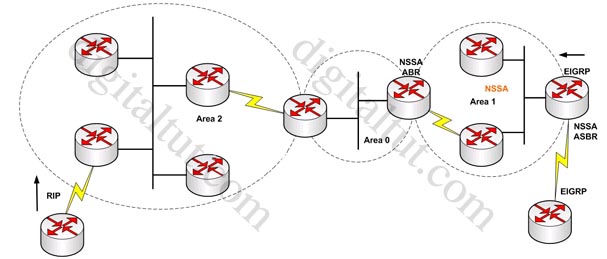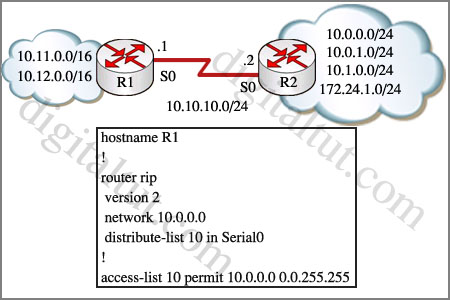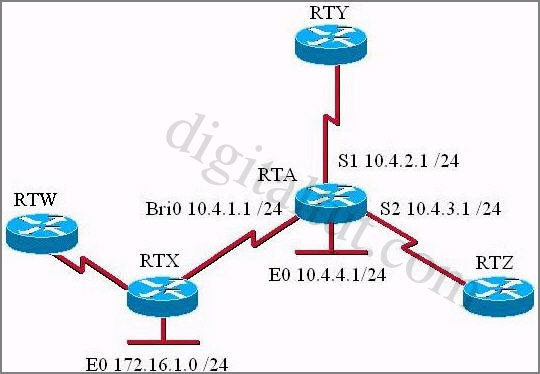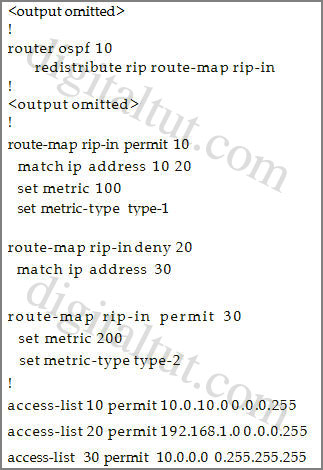Here you will find answers to Operation questions:
Question 1
Refer to the exhibit. Will redistributed RIP routes from OSPF Area 2 be allowed in Area 1?

A – Because Area 1 is an NSSA, redistributed RIP routes will not be allowed.
B – Redistributed RIP routes will be allowed in Area 1 because they will be changed into type 5 LSAs in Area 0 and passed on into Area 1
C – Because NSSA will discard type 7 LSAs, redistributed RIP routes will not be allowed in Area 1
D – Redistributed RIP routes will be allowed in Area 1 because they will be changed into type 7 LSAs in Area 0 and passed on into Area 1
Answer: A
Explanation
Because Area 1 is a Not-so-stubby-area (NSSA), we can inject EIGRP routes into the OSPF NSSA domain with the creation of type 7 LSAs. Redistributed RIP routes are not allowed in Area 1 because NSSA is an extension to the stub area (recall that a stub area does not accept external route unless it is connected through a ASBR, doing that will make it become a NSSA). The type 7 LSAs are converted to Type 5 LSAs when flooded into Area 0 by the ABR router.
Question 2
Study this exhibit below carefully. What is the effect of the distribute-list command in the R1 configuration?

A – R1 will permit only the 10.0.0.0/24 route in the R2 RIP updates
B – R1 will not filter any routes because there is no exact prefix match
C – R1 will filter the 10.1.0.0/24 and the 172.24.1.0/24 routes from the R2 RIP updates
D – R1 will filter only the 172.24.1.0/24 route from the P4S-R2 RIP updates
Answer: C
Explanation
The command “distribute-list 10 in Serial0″ will create an incoming distribute list for interface serial 0 and refers to access list 10. So it will permit routing updates from 10.0.x.x network while other entries (in this case the 10.1.0.0/24 and 172.24.1.0/24 networks) will be filtered out from the routing update received on interface S0.
Question 3
Which three route filtering statements are true? (Choose three)
A – After the router rip and passive-interface s0/0 commands have been issued, the s0/0 interface will not send any RIP updates, but will receive routing updates on that interface.
B – After the router eigrp 10 and passive-interface s0/0 commands have been issued, the s0/0 interface will not send any EIGRP updates, but will receive routing updates on that interface
C – After the router ospf 10 and passive-interface s0/0 commands have been issued , the s0/0 interface will not send any OSPF updates, but will receive routing updates on that interface
D – When you use the passive-interface command with RIPv2, multicasts are sent out the specified interface
E – When you use the passive-interface command with EIGRP, hello messages are not sent out the specified interface
F – When you use the passive-interface command with OSPF, hello messages are not sent out the specified interface
Answer: A E F
Explanation
Passive-interface command is used in all routing protocols to disable sending updates out from a specific interface. However the command behavior varies from one protocol to another”
- In RIP, this command will not allow sending multicast updates via a specific interface but will allow listening to incoming updates from other RIP speaking neighbors. This means that the router will still be able to receive updates on that passive interface and use them in its routing table.
In EIGRP and OSPF the passive-interface command stops sending outgoing hello packets, hence the router can not form any neighbor relationship via the passive interface. This behavior stops both outgoing and incoming routing updates.
Question 4
Router RTA is configured as follows:
RTA (config)#router rip
RTA(config-router)#network 10.0.0.0
RTA(config-router)#distribute-list 44 in interface BRIO
RTA(config-router)#exit
RTA(config)#access-list 44 deny 172.16.1.0 0.0.0.255
RTA(config)#access-list 44 permit any

What are the effects of this RIP configuration on router RTA? (Choose two)
A – no routing updates will be sent from router RTA on interface BRIO to router RTX
B – router RTA will not advertise the 10.0.0.0 network to router RTX
C – the route to network 172.16.1.0 will not be entered into the routing table on router RTA
D – user traffic from the 172.16.1.0 network is denied by access-list 44
E – the routing table on router RTA will be updated with the route to router RTW
Answer: C E
Explanation
Distribute list are used to filter routing updates and they are based on access lists. In this case, an access list of 44 was created to deny the route from network 172.16.1.0/24 so this route will not be entered into the routing table of RTA. But the route from RTW can be entered because it is not filtered by the access list
A and B are not correct because the distribute list is applied to the inbound direction of interface BRI0 so outgoing routing updated will not be filtered.
D is not correct because distribute list just filters routing updates so user traffic from network 172.16.1.0 will not be denied.
Question 5
Look at the following exhibit. Which of the following correctly states the routes to be redistributed into OSPF? (Choose two)

A – The network 10.0.10.0/24 will be allowed and assigned a metric of 200
B – All networks except 10.0.0.0/8 will be allowed and assigned a metric of 200
C – The network 172.16.0.0/16 will be allowed and assigned a metric of 200
D – The network 192.168.1.0 will be allowed and assigned a metric of 100
Answer: C D

